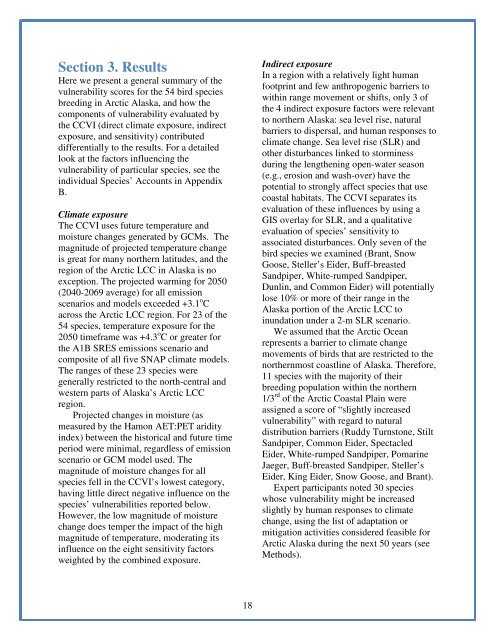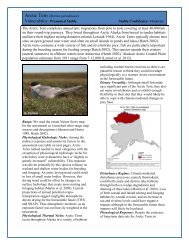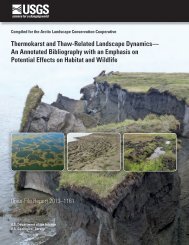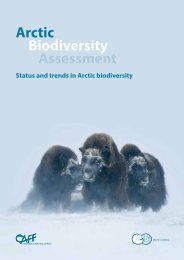Assessing Climate Change Vulnerability of Breeding Birds in Arctic ...
Assessing Climate Change Vulnerability of Breeding Birds in Arctic ...
Assessing Climate Change Vulnerability of Breeding Birds in Arctic ...
You also want an ePaper? Increase the reach of your titles
YUMPU automatically turns print PDFs into web optimized ePapers that Google loves.
Section 3. ResultsHere we present a general summary <strong>of</strong> thevulnerability scores for the 54 bird speciesbreed<strong>in</strong>g <strong>in</strong> <strong>Arctic</strong> Alaska, and how thecomponents <strong>of</strong> vulnerability evaluated bythe CCVI (direct climate exposure, <strong>in</strong>directexposure, and sensitivity) contributeddifferentially to the results. For a detailedlook at the factors <strong>in</strong>fluenc<strong>in</strong>g thevulnerability <strong>of</strong> particular species, see the<strong>in</strong>dividual Species’ Accounts <strong>in</strong> AppendixB.<strong>Climate</strong> exposureThe CCVI uses future temperature andmoisture changes generated by GCMs. Themagnitude <strong>of</strong> projected temperature changeis great for many northern latitudes, and theregion <strong>of</strong> the <strong>Arctic</strong> LCC <strong>in</strong> Alaska is noexception. The projected warm<strong>in</strong>g for 2050(2040-2069 average) for all emissionscenarios and models exceeded +3.1 o Cacross the <strong>Arctic</strong> LCC region. For 23 <strong>of</strong> the54 species, temperature exposure for the2050 timeframe was +4.3 o C or greater forthe A1B SRES emissions scenario andcomposite <strong>of</strong> all five SNAP climate models.The ranges <strong>of</strong> these 23 species weregenerally restricted to the north-central andwestern parts <strong>of</strong> Alaska’s <strong>Arctic</strong> LCCregion.Projected changes <strong>in</strong> moisture (asmeasured by the Hamon AET:PET aridity<strong>in</strong>dex) between the historical and future timeperiod were m<strong>in</strong>imal, regardless <strong>of</strong> emissionscenario or GCM model used. Themagnitude <strong>of</strong> moisture changes for allspecies fell <strong>in</strong> the CCVI’s lowest category,hav<strong>in</strong>g little direct negative <strong>in</strong>fluence on thespecies’ vulnerabilities reported below.However, the low magnitude <strong>of</strong> moisturechange does temper the impact <strong>of</strong> the highmagnitude <strong>of</strong> temperature, moderat<strong>in</strong>g its<strong>in</strong>fluence on the eight sensitivity factorsweighted by the comb<strong>in</strong>ed exposure.Indirect exposureIn a region with a relatively light humanfootpr<strong>in</strong>t and few anthropogenic barriers towith<strong>in</strong> range movement or shifts, only 3 <strong>of</strong>the 4 <strong>in</strong>direct exposure factors were relevantto northern Alaska: sea level rise, naturalbarriers to dispersal, and human responses toclimate change. Sea level rise (SLR) andother disturbances l<strong>in</strong>ked to storm<strong>in</strong>essdur<strong>in</strong>g the lengthen<strong>in</strong>g open-water season(e.g., erosion and wash-over) have thepotential to strongly affect species that usecoastal habitats. The CCVI separates itsevaluation <strong>of</strong> these <strong>in</strong>fluences by us<strong>in</strong>g aGIS overlay for SLR, and a qualitativeevaluation <strong>of</strong> species’ sensitivity toassociated disturbances. Only seven <strong>of</strong> thebird species we exam<strong>in</strong>ed (Brant, SnowGoose, Steller’s Eider, Buff-breastedSandpiper, White-rumped Sandpiper,Dunl<strong>in</strong>, and Common Eider) will potentiallylose 10% or more <strong>of</strong> their range <strong>in</strong> theAlaska portion <strong>of</strong> the <strong>Arctic</strong> LCC to<strong>in</strong>undation under a 2-m SLR scenario.We assumed that the <strong>Arctic</strong> Oceanrepresents a barrier to climate changemovements <strong>of</strong> birds that are restricted to thenorthernmost coastl<strong>in</strong>e <strong>of</strong> Alaska. Therefore,11 species with the majority <strong>of</strong> theirbreed<strong>in</strong>g population with<strong>in</strong> the northern1/3 rd <strong>of</strong> the <strong>Arctic</strong> Coastal Pla<strong>in</strong> wereassigned a score <strong>of</strong> “slightly <strong>in</strong>creasedvulnerability” with regard to naturaldistribution barriers (Ruddy Turnstone, StiltSandpiper, Common Eider, SpectacledEider, White-rumped Sandpiper, Pomar<strong>in</strong>eJaeger, Buff-breasted Sandpiper, Steller’sEider, K<strong>in</strong>g Eider, Snow Goose, and Brant).Expert participants noted 30 specieswhose vulnerability might be <strong>in</strong>creasedslightly by human responses to climatechange, us<strong>in</strong>g the list <strong>of</strong> adaptation ormitigation activities considered feasible for<strong>Arctic</strong> Alaska dur<strong>in</strong>g the next 50 years (seeMethods).18








